Last Updated on October 1, 2012
When we travel, we always have a plan. Not that we stick to it, but we always intend to.
It might seem predictable, but the truth is there is a reason why travelers follow a trail, at least roughly. It is because the routes make sense to follow – from north to south or from main hub to main hub, making your stops along the way.
There are the times when I just want to pick up the guidebook, point to a page, and go there.
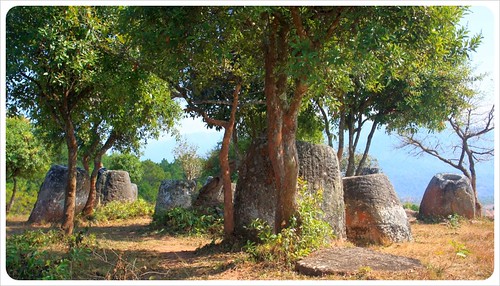 One day at lunch in Laos, while eating a baguette in the French colonial city of Luang Prabang, I was flipping mindlessly through the guidebook, and came upon a place called the Plain of Jars. The name already had me hooked, but the description possessed me. What is this plain filled with jars, I wondered?
One day at lunch in Laos, while eating a baguette in the French colonial city of Luang Prabang, I was flipping mindlessly through the guidebook, and came upon a place called the Plain of Jars. The name already had me hooked, but the description possessed me. What is this plain filled with jars, I wondered?
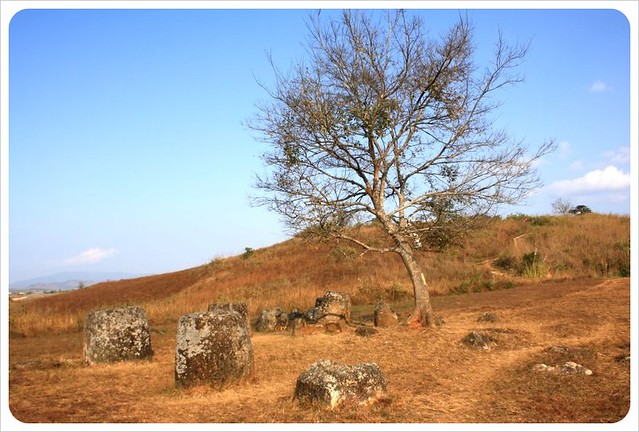 French archeologist Madeleine Colan (re)discovered the Plain of Jars in 1930 (along with a few bones, teeth and shards of pottery) on a plateau in the north east of Laos. Hundreds of these ancient Stone Age jars reach as high as 3m and weigh between 650kg and one metric ton. Their purpose remains a mystery to archeologists, who have put the site on par with Stonehenge or Easter Island’s Moai statues in terms of mystery and massive size. Now, this is what traveling is all about, I thought.
French archeologist Madeleine Colan (re)discovered the Plain of Jars in 1930 (along with a few bones, teeth and shards of pottery) on a plateau in the north east of Laos. Hundreds of these ancient Stone Age jars reach as high as 3m and weigh between 650kg and one metric ton. Their purpose remains a mystery to archeologists, who have put the site on par with Stonehenge or Easter Island’s Moai statues in terms of mystery and massive size. Now, this is what traveling is all about, I thought.
We had to get to these Jars.
Despite the extra two days of travel on those nauseating Lao roads, the detour was worth it. The next day, we were off to see these jars in the Xieng Khouang province.
Its dusty capital, Phonsavan, acts as the hub for visitors to the region. Streets here are wide with soviet-style blocks and piles of rubble and bricks on either side. There are only practical businesses, repair shops and a smattering of basic restaurants and hotels. As we arrive in the late afternoon light, the scene is more how we would have imagined a trip to Mongolia. Motorcycle riders with scarves over their faces to block the dust, the cityscape here is barren but you see from the construction that there is prosperity in its future.
We loved Phonsavan right away.
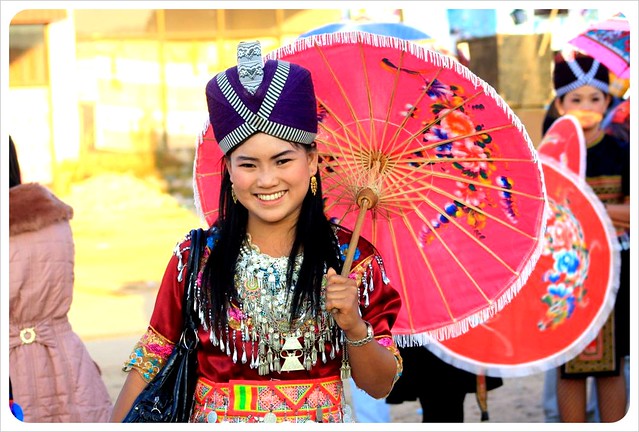 We set our bags down in a sturdy, basic hotel room off the main road, ready to hunt for some dinner, and the sound of festive music started pounding through the window. It just so happened that we were not only going to be learning about ancient cultures here in Phonsavan, but also experiencing the Hmong New Year at the same time.
We set our bags down in a sturdy, basic hotel room off the main road, ready to hunt for some dinner, and the sound of festive music started pounding through the window. It just so happened that we were not only going to be learning about ancient cultures here in Phonsavan, but also experiencing the Hmong New Year at the same time.
Originating from Southeastern China, the Hmong ethnic group slowly migrated into the highlands of Thailand, Vietnam and Laos throughout the 18th century due to unrest, and outside of Phonsavan is one of the largest Hmong communities in the world. Just near our hotel, a huge open gravel lot was spilling over with Hmong people of all ages, all dressed in their colorful festive best. New Year’s celebrations come at the end of the harvest season and involve up to 40 days of food, dancing and a fun fair.
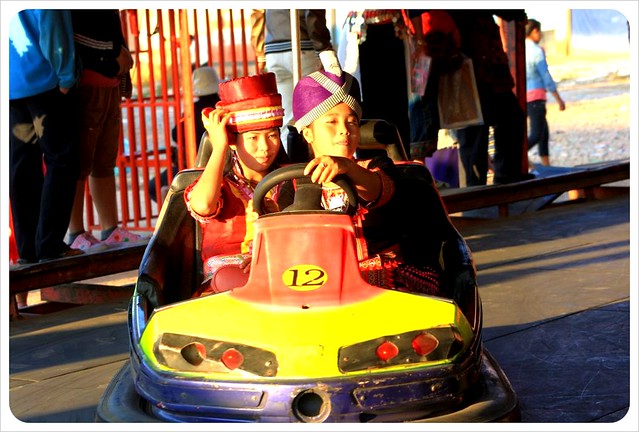 We made a bit of small talk with a trio of Hmong girls eager to practice their English and happily pose for pictures in their beautiful robes for a few minutes. Then it was off to find a guide for the Plain of Jars the next day. Visitors can hire a driver to the main site on their own, but guides are required for sites 2 and 3, not only because of the distance, but also because the area surrounding the two sites is still littered with landmines. We were happy to have an expert with us to keep us safe, but also to tell us more about the history of the jars.
We made a bit of small talk with a trio of Hmong girls eager to practice their English and happily pose for pictures in their beautiful robes for a few minutes. Then it was off to find a guide for the Plain of Jars the next day. Visitors can hire a driver to the main site on their own, but guides are required for sites 2 and 3, not only because of the distance, but also because the area surrounding the two sites is still littered with landmines. We were happy to have an expert with us to keep us safe, but also to tell us more about the history of the jars.
Was this place inhabited by giants?
Lao legend claims that the region was populated by a race of giants thousands of years ago. More rational theories suggest that these jars, which date from to 500BC – 200AD, were used as funerary urns to bury to dead, or to catch rain water, or maybe even to brew and store the (in)famous Lao Lao rice whiskey.
 Unfortunately, few jars today remain completely in tact. Locals have used pieces throughout time for building materials while trees have sprung right up out the middle of others. Many fell victim to bombs dropped here during the U.S.-led Secret War. The Laos government has applied for UNESCO World Heritage status for funding to prevent further destruction, but until the thousands of unexploded landmines from that war can be cleared (a dangerous task costing millions of dollars), it is unlikely they will receive UNESCO’s blessing.
Unfortunately, few jars today remain completely in tact. Locals have used pieces throughout time for building materials while trees have sprung right up out the middle of others. Many fell victim to bombs dropped here during the U.S.-led Secret War. The Laos government has applied for UNESCO World Heritage status for funding to prevent further destruction, but until the thousands of unexploded landmines from that war can be cleared (a dangerous task costing millions of dollars), it is unlikely they will receive UNESCO’s blessing.
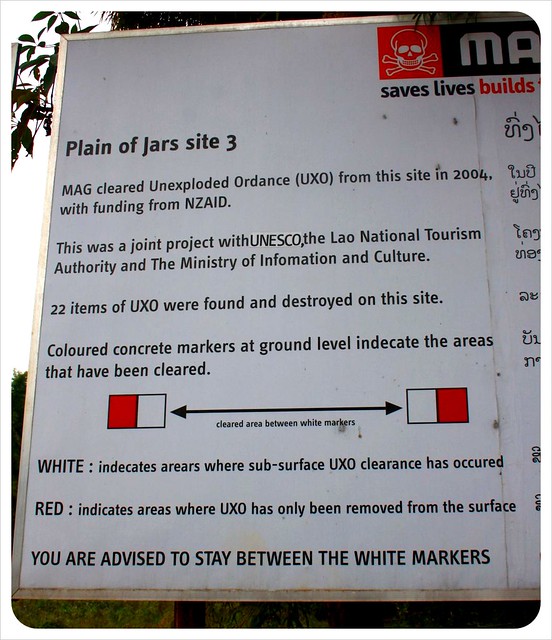 For such a mysterious and ancient site, there are very few visitors here. With a twinkle in his eye, our guide explained that as soon as UNESCO status is granted, tourists will flock to the Plain of Jars the way they do to Luang Prabang or Cambodia’s Angkor Wat.
For such a mysterious and ancient site, there are very few visitors here. With a twinkle in his eye, our guide explained that as soon as UNESCO status is granted, tourists will flock to the Plain of Jars the way they do to Luang Prabang or Cambodia’s Angkor Wat.
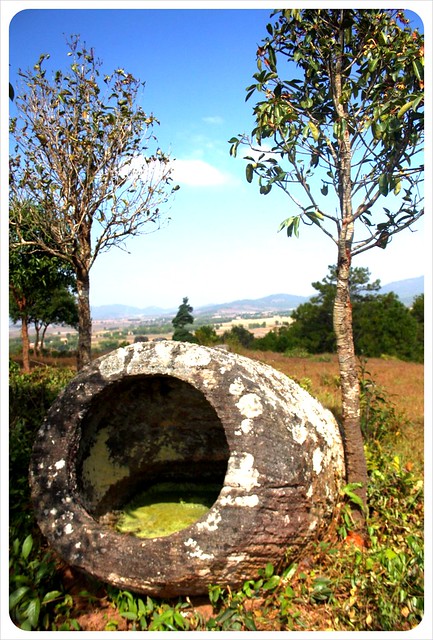 After all, everything about these jars is fascinating – their size, their mysterious history and also just how much ground these sites cover. There are three sites, spread over a massive amount of land and we start at the further one, site three, which sits 35km from Phonsavan.
After all, everything about these jars is fascinating – their size, their mysterious history and also just how much ground these sites cover. There are three sites, spread over a massive amount of land and we start at the further one, site three, which sits 35km from Phonsavan.
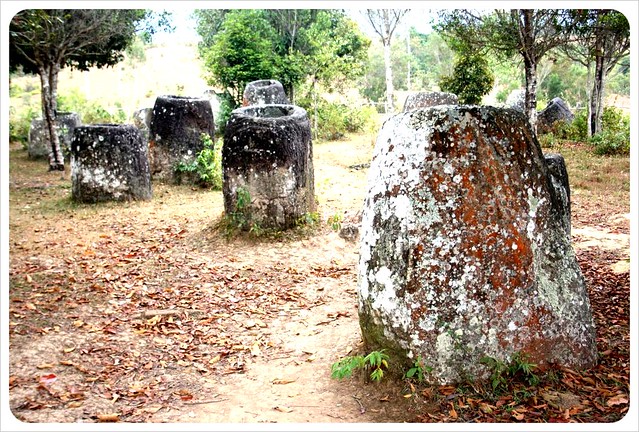 The Plain of Jars and a break at a rice whiskey factory
The Plain of Jars and a break at a rice whiskey factory
After a gut-jostling ride down a series of makeshift dirt roads, we parked at a gate and proceeded to hike fifteen minutes past muscular farmers mucking knee deep through rice fields to the top of a hill where 150 of the massive clay jars are strewn about – that is, if massive 700kg jars can be considered ‘strewn’. Rapid-fire questions immediately started. How in the world were these jars transported up here? How were they even made? Were they made nearby? No one knows for sure, is all we were told.
 Each jar varies in size, some are the size and mass of a small car, while others are smaller, like a heavy-duty backyard barbecue. Picturing the diminutive ancestors lugging these up a hill is difficult, and it is clear why legend has it that giants used to inhabit the area. After a bit of gawking and talking, we hiked back down and were transported to Site 2. Here there are only 90 jars, spread out across two facing hillsides. The views from here spread deep into the Lao countryside, revealing both intimate village scenes and expansive view that made us feel as if we were the only ones here within one hundred miles.
Each jar varies in size, some are the size and mass of a small car, while others are smaller, like a heavy-duty backyard barbecue. Picturing the diminutive ancestors lugging these up a hill is difficult, and it is clear why legend has it that giants used to inhabit the area. After a bit of gawking and talking, we hiked back down and were transported to Site 2. Here there are only 90 jars, spread out across two facing hillsides. The views from here spread deep into the Lao countryside, revealing both intimate village scenes and expansive view that made us feel as if we were the only ones here within one hundred miles.
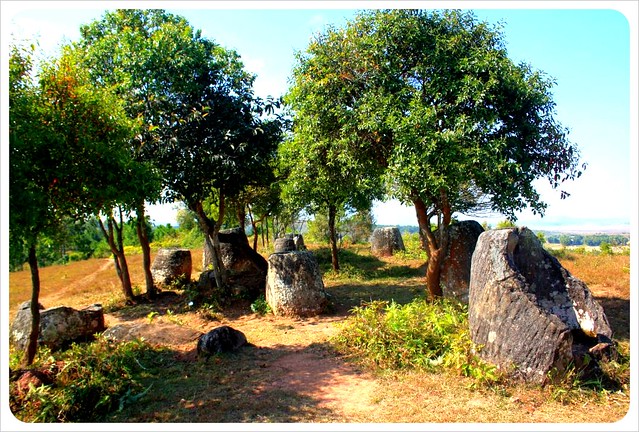 One basic lunch later, the next stop of the tour brought us to a Lao Lao whiskey ‘factory’. This was no more than a house with ten barrels of fermenting booze, a few lazy dogs out front and a charming, older lady who explained through pointing and smiles how this fire water is produced.
One basic lunch later, the next stop of the tour brought us to a Lao Lao whiskey ‘factory’. This was no more than a house with ten barrels of fermenting booze, a few lazy dogs out front and a charming, older lady who explained through pointing and smiles how this fire water is produced.
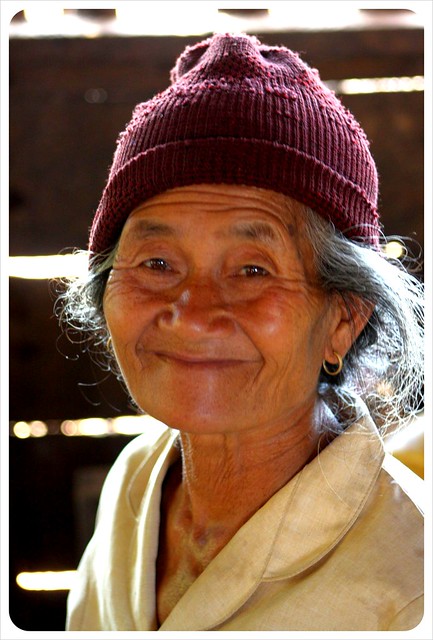 Hi-tech kids playing a traditional game of flirtation
Hi-tech kids playing a traditional game of flirtation
With our insides still on fire from the ‘whiskey’, we hopped into the shuttle to finally arrive at the main site, Site 1, where 250 jars were waiting. It was officially New Year’s Day, and so we arrived on a most colorful scene as hundreds of Hmong people crowded here at the region’s most significant site to celebrate. Most of us hung back, just observing, until a group of teenagers invited us to join them in what was essentially a hill tribe version of speed dating!
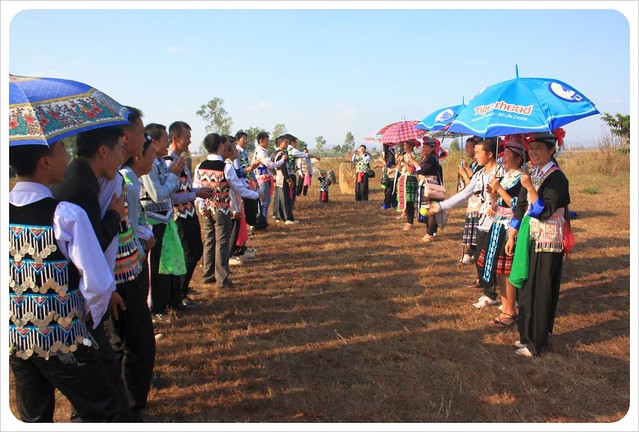 The game is called Pov Pob, the Hmong Game of Love. All in intricately designed traditional outfits, girls line up on one side across from the boys. Tossing a tennis ball back and forth, they throw the ball to someone they like. If caught, that person returns the flirtation. If they let the ball drop, then they do not see their ‘suitor’ as marriage material.
The game is called Pov Pob, the Hmong Game of Love. All in intricately designed traditional outfits, girls line up on one side across from the boys. Tossing a tennis ball back and forth, they throw the ball to someone they like. If caught, that person returns the flirtation. If they let the ball drop, then they do not see their ‘suitor’ as marriage material.
 The teen boys especially took to Dani’s blond hair and invited her to play, and the girls politely giggled at them for trying. This is the first step of their entire marriage process, so, of course Dani declined and settled for becoming the subject of dozens of cell phone pictures. After all, as traditional as these festivities are, even here in the middle of rural Laos, where there are teenagers, there is a high-tech situation. With mp3 players shoved in the pockets of their traditional outfits, some played Pov Pob one handed while texting, while others recorded the experience on their devices.
The teen boys especially took to Dani’s blond hair and invited her to play, and the girls politely giggled at them for trying. This is the first step of their entire marriage process, so, of course Dani declined and settled for becoming the subject of dozens of cell phone pictures. After all, as traditional as these festivities are, even here in the middle of rural Laos, where there are teenagers, there is a high-tech situation. With mp3 players shoved in the pockets of their traditional outfits, some played Pov Pob one handed while texting, while others recorded the experience on their devices.
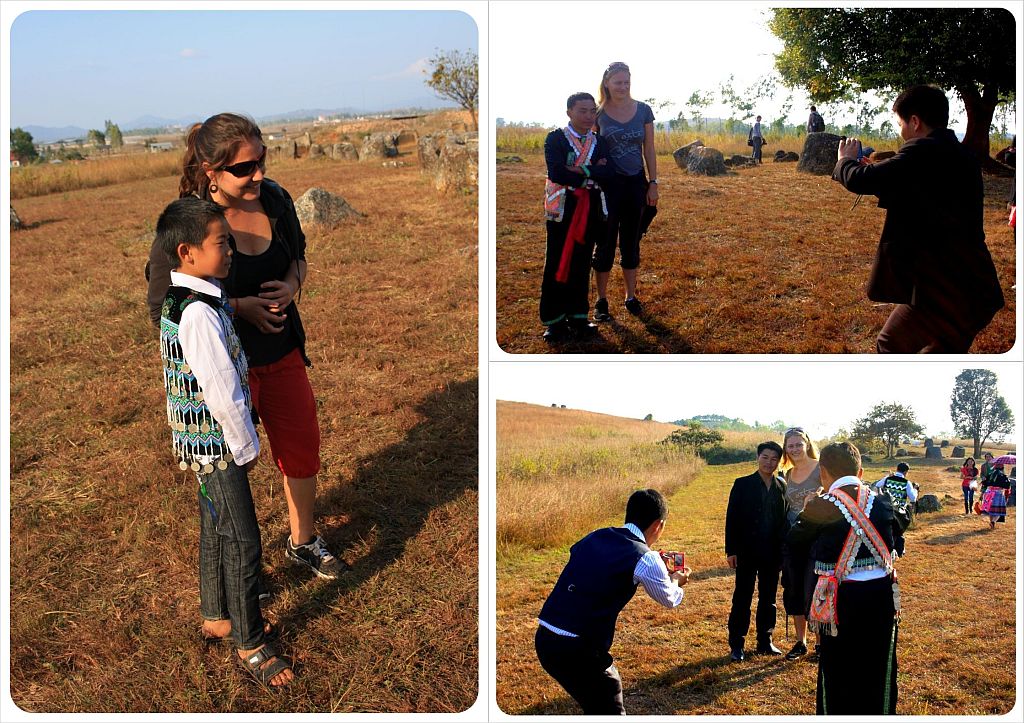 As for the jars at the main site, they were truly massive and, even after a long day of touring, inspired such wonder as to how in the world, and why in the world, they have been here, since the Stone Age.
As for the jars at the main site, they were truly massive and, even after a long day of touring, inspired such wonder as to how in the world, and why in the world, they have been here, since the Stone Age.
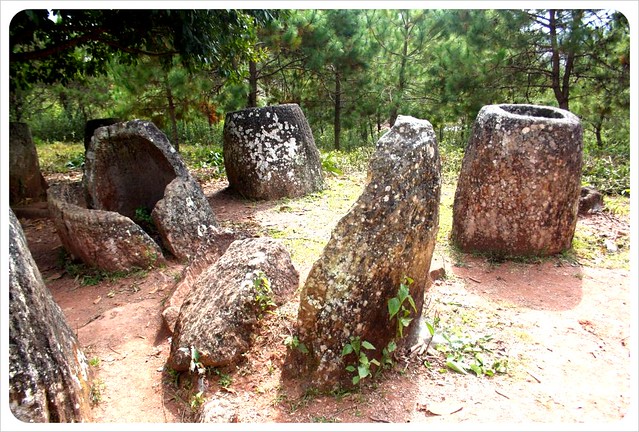 The Details: The Plain of Jars
The Details: The Plain of Jars
The tour can be booked anywhere – shop around a bit if you care, prices vary by a few dollars, but they all feed into the same minivans. There are a variety of tours which focus more on the Secret War, the Hmong people, and other aspects of life in Laos. Check out this informative Xieng Khouang website for more.
What to do in Phonsavan
There isn’t much in the way of diversion in Phonsavan, but anyone looking to see the Plain of Jars must overnight here at least once as it is too far from anywhere else.
Bomb Harvest: Once here, you might as well at least pop in to watch this documentary. The MAG (Mines Advisory Group) is the organization controlling the clearance of the Unexploded Ordnances (UXO) around Phonsavan. Their office in town offers a daily screening of Bomb Harvest, about the consequences of the heavy bombings and UXO and the efforts to clean up the nearly 200,000 that remain.
Phonsavan Daily Market: The daily market the town center of Phonsavan is one of the most interesting markets in Laos, featuring the many unusual culinary specialties of the Xieng Khouang province. You will see fried bats, colorful birds, squirrels, porcupines and other big rodents ready for cooking. This is nothing for sensitive animal lovers but fascinating for everyone who is interested in getting an insight into local culture.
Where to stay in Phonsavan
Despite the long journey required from other major hubs in Laos, there are plenty of hotels in Phonsavan. Guesthouses in town offer double rooms for around 100,000 kip ($12.50) and a good selection have (sometimes patchy) Wi-Fi. The Plain of Jars tends to attract a more studied (older) tourist, and therefore there are quite a few mid-range hotels as well.
Where to eat in Phonsavan
We ate breakfast, lunch and dinner at Nisha – a family-run hole in the wall Indian restaurant with plenty of western food on the menu. The food is delicious and cheap, and we ran into plenty of other travelers here two and three times.
The Craters Bar & Restaurant offers several Western dishes and has free wi-fi, and the Kong Keo Restaurant is rumored to have good local Lao food.
 How to get to Phonsavan
How to get to Phonsavan
Phonsavan makes a great stop on the way to the Vietnam border and can be reached by direct bus from Luang Prabang or Vientiane. Times seem to vary by seasons and weekdays/ends, but we find the Wikitravel entry for Phonsavan very useful.

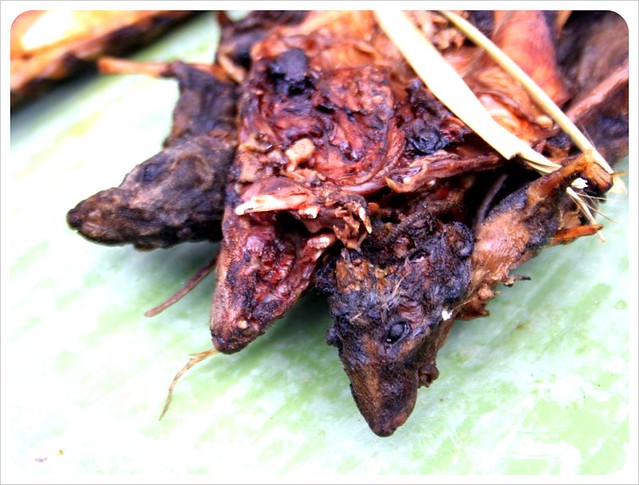

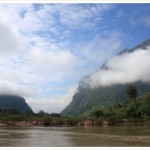

Around the Web Travel Roundup | Trip Logic
Wednesday 26th of November 2014
[…] yes, I’d like to visit a place rumored to have once been inhabited by giants, yes I […]
Sean
Monday 12th of August 2013
Hi guys.
Great read!
Unfortunately I didn't get to visit the plain of jars when I was in Laos. It seems really, really interesting. I suppose going there when its the Hmong New Year would be even more interesting. Can't wait to go back to Laos. Miss those delicious baguettes!
Dani
Tuesday 13th of August 2013
Hi Sean, yes these baguettes were amazing! Laos is definitely on our list of places to return to, too - and the Hmong New Year was a really special experience, I hope you'll get to experience it one day.
Stefan Russel
Thursday 21st of March 2013
The Plain of Jars id definitely one of the most special places I have been to.
Apart from the fascination of the jars, one of the things that still stick in my mind was the cratered landscape below us when we flew into Phonsavan. It really made you think.
I loved the place and I really like your photos - great colors.
Stefan
Alex in Wanderland | Travel and Diving Blog | The Sights of Vientiane
Saturday 28th of July 2012
[...] charm box was ticked before I even entered. I swooned over these sweet murals, depicting the famous Plain of Jars and Wat Pha That Luang. The exterior marked the perfect balance between decrepit and [...]
Dina
Thursday 24th of May 2012
OMG, quite rarely I'm jealous with people's post, but this one makes me that way! I really want to see the Hmong's New Year! I want to see the people wearing the costumes as a part of their real traditions, not just for a tourist display. I read and watched the video about the ball throwing game in Luang Prabang's museum (a textile museum?), and so want to watch it! You guys are really lucky!!
I need to go back there........
Dani
Friday 25th of May 2012
We had no idea we would stumble upon the Hmong New Year when we pulled into Phonsavan - it was one of the times when we were really lucky! We loved the customs and learning about their traditions - such an interesting culture. We love that we learn about all these random things while we travel!